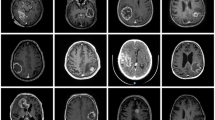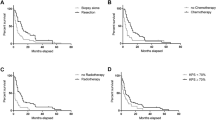Abstract
The diagnosis of glioblastoma (GBM) often carries a dismal prognosis, with a median survival of 14.6 months. A particular challenge is the diagnosis of GBM in the elderly population (age > 75 years), who have significant comorbidities, present with worse functional status, and are at higher risk with surgical treatments. We sought to evaluate the impact of current GBM treatment, specifically in the elderly population. The authors undertook a retrospective review of all patients aged 75 or older who underwent treatment for GBM from 1997 to 2016. Patient outcomes were evaluated with regards to demographics, surgical variables, postoperative treatment, and complications. A total of 82 patients (mean age 80.5 ± 3.8 years) were seen. Most patients presented with confusion (57.3%) and associated comorbidities, and prior anticoagulation use was common in this age group. Extent of resection (EOR) included no surgery (9.8%), biopsy (22.0%), subtotal resection (40.2%), and gross-total resection (23.2%). Postoperative adjuvant therapy included temozolomide (36.1%), radiation (52.5%), and bevacizumab (11.9%). A mean overall survival of 6.3 ± 1.2 months was observed. There were 34 complications in 23 patients. Improved survival was seen with increased EOR only for patients without postoperative complications. A multivariate Cox proportional hazards model showed that complications (HR = 5.43, 95% CI 1.73, 17.04, p = 0.004) predicted poor outcome. Long-term survivors (> 12 months survival) and short-term survivors had similar median preoperative Karnofsky Performance Scale (KPS) score (80 vs. 80, p = 0.43), but long-term survivors had unchanged postoperative KPS (80 vs. 60, p = 0.02) and no complications (0/9 vs. 23/72, p = 0.04). The benefit of glioblastoma treatment in our series was limited by the postoperative complications and KPS. Presence of a complication served as an independent risk factor for worsened overall survival in this age group. It is likely that decreased patient function limits postoperative adjuvant therapy and predisposes to higher morbidity especially in this age group.


Similar content being viewed by others
References
Alvarez de Eulate-Beramendi S, Alvarez-Vega MA, Balbin M, Sanchez-Pitiot A, Vallina-Alvarez A, Martino-Gonzalez J (2016) Prognostic factors and survival study in high-grade glioma in the elderly. Br J Neurosurg 30:330–336
Babu R, Komisarow JM, Agarwal VJ, Rahimpour S, Iyer A, Britt D et al (2016) Glioblastoma in the elderly: the effect of aggressive and modern therapies on survival. J Neurosurg 124:998–1007
Bauchet L, Mathieu-Daude H, Fabbro-Peray P, Rigau V, Fabbro M, Chinot O et al (2010) Oncological patterns of care and outcome for 952 patients with newly diagnosed glioblastoma in 2004. Neuro Oncol 12:725–735
Bloch O, Han SJ, Cha S, Sun MZ, Aghi MK, McDermott MW et al (2012) Impact of extent of resection for recurrent glioblastoma on overall survival: clinical article. J Neurosurg 117:1032–1038
Chaichana KL, Chaichana KK, Olivi A, Weingart JD, Bennett R, Brem H et al (2011) Surgical outcomes for older patients with glioblastoma multiforme: preoperative factors associated with decreased survival. Clinical article. J Neurosurg 114:587–594
Chibbaro S, Di Rocco F, Makiese O, Mirone G, Marsella M, Lukaszewicz AC et al (2010) Neurosurgery and elderly: analysis through the years. Neurosurg Rev 34:229–234
Grabowski MM, Recinos PF, Nowacki AS, Schroeder JL, Angelov L, Barnett GH et al (2014) Residual tumor volume versus extent of resection: predictors of survival after surgery for glioblastoma. J Neurosurg 121:1115–1123
Guedes de Castro D, Matiello J, Roa W, Ghosh S, Kepka L, Kumar N et al (2017) Survival outcomes with short-course radiation therapy in elderly patients with glioblastoma: data from a randomized phase 3 trial. Int J Radiat Oncol Biol Phys 98:931–938
Hardesty DA, Sanai N (2012) The value of glioma extent of resection in the modern neurosurgical era. Front Neurol 3:140
Ikawa F, Kinoshita Y, Takeda M, Saito T, Yamaguchi S, Yamasaki F et al (2017) Review of current evidence regarding surgery in elderly patients with meningioma. Neurol Med Chir 57: 521–533
Jain A, Hassanzadeh H, Puvanesarajah V, Klineberg EO, Sciubba DM, Kelly MP et al (2017) Incidence of perioperative medical complications and mortality among elderly patients undergoing surgery for spinal deformity: analysis of 3519 patients. J Neurosurg Spine 27: 534–539
Lacroix M, Abi-Said D, Fourney DR, Gokaslan ZL, Shi W, DeMonte F et al (2001) A multivariate analysis of 416 patients with glioblastoma multiforme: prognosis, extent of resection, and survival. J Neurosurg 95:190–198
Laperriere N, Weller M, Stupp R, Perry JR, Brandes AA, Wick W et al (2013) Optimal management of elderly patients with glioblastoma. Cancer Treat Rev 39:350–357
Li YM, Suki D, Hess K, Sawaya R (2016) The influence of maximum safe resection of glioblastoma on survival in 1229 patients: Can we do better than gross-total resection? J Neurosurg 124:977–988
Noorbakhsh A, Tang JA, Marcus LP, McCutcheon B, Gonda DD, Schallhorn CS et al (2014) Gross-total resection outcomes in an elderly population with glioblastoma: a SEER-based analysis. J Neurosurg 120:31–39
Ohkuma H, Shimamura N, Naraoka M, Katagai T (2017) Aneurysmal subarachnoid hemorrhage in the elderly over age 75: a systematic review. Neurol Med Chir 57: 575–583
Oszvald A, Guresir E, Setzer M, Vatter H, Senft C, Seifert V et al (2012) Glioblastoma therapy in the elderly and the importance of the extent of resection regardless of age. J Neurosurg 116:357–364
Park M, Lee SK, Chang JH, Kang SG, Kim EH, Kim SH et al (2017) Elderly patients with newly diagnosed glioblastoma: can preoperative imaging descriptors improve the predictive power of a survival model? J Neurooncol 134:423–431
Perry JR, Laperriere N, O’Callaghan CJ, Brandes AA, Menten J, Phillips C et al (2017) Short-course radiation plus temozolomide in elderly patients with glioblastoma. N Engl J Med 376:1027–1037
Sanai N, Berger MS (2008) Glioma extent of resection and its impact on patient outcome. Neurosurgery 62:753–764
Sanai N, Polley MY, McDermott MW, Parsa AT, Berger MS (2011) An extent of resection threshold for newly diagnosed glioblastomas. J Neurosurg 115:3–8
Scott JG, Suh JH, Elson P, Barnett GH, Vogelbaum MA, Peereboom DM et al (2011) Aggressive treatment is appropriate for glioblastoma multiforme patients 70 years old or older: a retrospective review of 206 cases. Neuro Oncol 13:428–436
Stummer W, Reulen HJ, Meinel T, Pichlmeier U, Schumacher W, Tonn JC et al (2008) Extent of resection and survival in glioblastoma multiforme: identification of and adjustment for bias. Neurosurgery 62:564–576
Stupp R, Mason WP, van den Bent MJ, Weller M, Fisher B, Taphoorn MJ et al (2005) Radiotherapy plus concomitant and adjuvant temozolomide for glioblastoma. N Engl J Med 352:987–996
Torrance AD, Powell SL, Griffiths EA (2015) Emergency surgery in the elderly: challenges and solutions. Open Access Emerg Med 7:55–68
Zhang C, Wang X, Hao S, Su Z, Zhang P, Li Y et al (2016) Analysis of treatment tolerance and factors associated with overall survival in elderly patients with glioblastoma. World Neurosurg 95:77–84
Acknowledgements
We thank Kristin Kraus, M.Sc., for her editorial assistance.
Author information
Authors and Affiliations
Corresponding author
Rights and permissions
About this article
Cite this article
Karsy, M., Yoon, N., Boettcher, L. et al. Surgical treatment of glioblastoma in the elderly: the impact of complications. J Neurooncol 138, 123–132 (2018). https://doi.org/10.1007/s11060-018-2777-9
Received:
Accepted:
Published:
Issue Date:
DOI: https://doi.org/10.1007/s11060-018-2777-9




